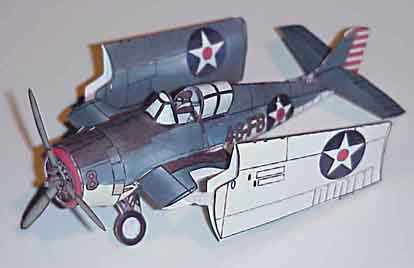
Grumman WWII Navy F4F Wildcat
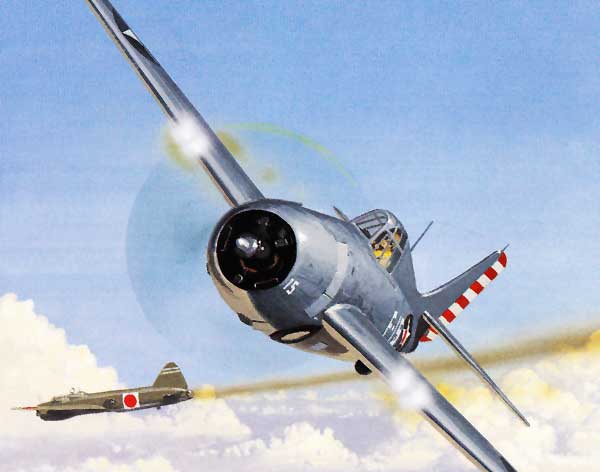
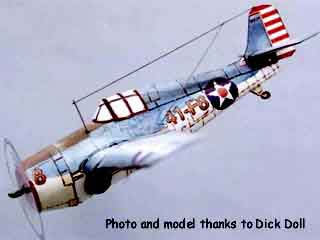
Though inferior in some respects to the Japanese Zero, the F4F Wildcat was much tougher and had a kill ratio of 6.9:1. They were standard equipment until the end of World War II. Ours has removable wings so you can display it in a folded position.
The Wildcat was Grumman's first monoplane and one of the outstanding
Naval fighters of World War II. The F4F design began in 1935.
Thanks...oh...the blue-over-gray color on the Buffalo and Wildcat? In June 42, they still used a kind of darkish sea-gray over light gray. Good illustrations as you know on Wings Palette. I played games with my printer with your Wildcat and made a mess, didn't Sorry. Getting like a busybody old man! Bill
Grumman Wildcat Cardmodel from Fiddlersgreen
|
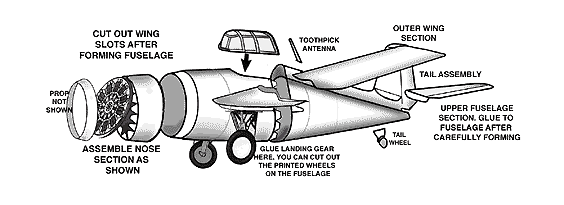
Grumman's first monoplane and one of the outstanding Naval fighters of World War II, the F4F design began in 1935 while the company's latest biplane for the USN, the XF3F-1, was still undergoing its initial tests. In November 1935 the USN initiated a formal design competition for a new carrier-based fighter and during the early months selected Brewster and Grumman designs for prototype testing. The Brewster F2A-1 was a monoplane-the first adopted by the Navy at the design stage- while the Grumman XF4F-1 was a biplane, backed by the USN primarily as an insurance against failure of the monoplane.
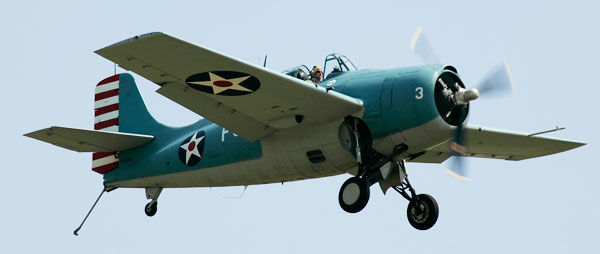
Ordered on March 2, 1936, the XF4F-1 was an equal-span biplane of 4,500 lb gross weight with a Pratt & Whitney R-1535-92 engine. However, data on the Brewster aeroplane soon showed that the biplane could not compete with a successful monoplane, while steady development of the F3F improved its performance nearly to equal that of the projected XF4F-l. Further work on the latter consequently seemed pointless, and an alternative monoplane was designed by Grumman. This was ordered by the Navy on July 28, 1936, as the XF4F-2, and in this completely revised form the Grumman design was destined for far greater success than ever achieved by its Brewster-designed contemporary.
Powered by a 1,050 hp Pratt & Whitney R-1830-66
Twin Wasp engine, the XF4F-2 (Grumman G-18) had a gross weight
of 5,535 lb and a design maximum speed of 290 mph. It was a mid-wing
all-metal monoplane with an armament of two 0.50-in guns in the
fuselage and provision for two more in the wings, or two 100 lb
bombs beneath the wings. The main wheels of the undercarriage
retracted into the fuselage in typical Grumman fashion. First
flight was made from the Grumman Long Island factory at Bethpage
on September 2, 1937, and company and Navy testing occupied the
next nine months. Official trial results credited the XF4F-1 with
a top speed of 290 mph, 10 mp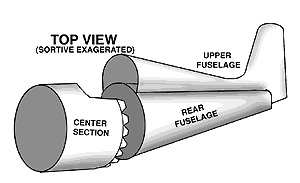 h better than the F2A-l, but in several
other respects it was rated less satisfactory, and the Brewster
aeroplane was declared winner of the design contest in June 1938.
h better than the F2A-l, but in several
other respects it was rated less satisfactory, and the Brewster
aeroplane was declared winner of the design contest in June 1938.
The Grumman design had appeared too promising to neglect altogether, however, and in October 1938 the Navy contracted for a modified prototype to be powered by a version of the Twin Wasp with a two-stage two speed supercharger, the XR-1830-76. In addition to the new engine installation, this modified XF4F-3 (Grumman G-36) had increased wing span with blunt tips, revised tail surfaces and higher gross weight.
The first flight of the XF4F-3 was made on February 12, 1939, and in subsequent Navy trials a speed of 3335 mph was recorded at 21,300 ft, ample evidence of the improvement bestowed by the two-stage supercharger. Although engine cooling proved to be a major problem, the potential of the Grumman fighter was now clearly established and in August 1939 the Navy ordered 54 F3F-3s. Work, in fact, had already been started by Grumman in anticipation of the order, and the first production F4F-3 was ready to fly in February 1940. Other aircraft followed in rapid succession and introduced various modifications. The first two F4F-3s had two 0.30-in fuselage guns and two OSOs in the wings; subsequently, four OSOs in the wings became standard. Nos. 3 and 4 off the line were completed in June 1940 with Wright R-1820-40 engines and designated XF4F-5, while Nos. 5 and 8 had armour protection and strengthened landing gear. All production aircraft used a new high tailplane position.
Export orders for the Grumman G-36 had been placed in 1939, when France purchased 81; this entire order was transferred to Britain in June 1940, and the first aircraft, with its British name of Martlet I, was delivered on July 27, 1940, ahead of F4F-3 deliveries to the USN. By December 1940, 22 F4F-3s had been accepted by the Navy, and initial deliveries were being made to VF-4 (USS Ranger) and VF-7 (USS Wasp) at Norfolk Naval Air Station in Virginia. During 1941, VF-42 and VF-71 were equipped with F4F-3s as well as Marine Squadrons VMF-121, 211 and 221.
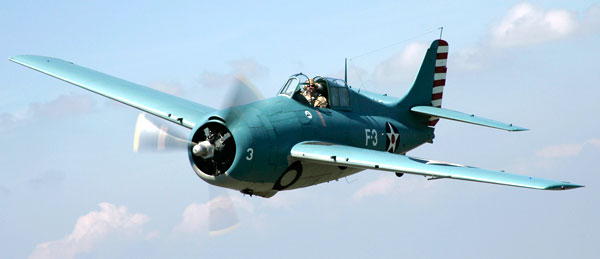
In addition to further contracts for the F4F-3, Grumman received a USN order for 95 F4F-3As, these being powered by R-1830-90 engines with single-stage superchargers. A prototype installation of this engine had been made in the single XF4F-6 late in 1940 when the two-stage blower was still giving trouble; production of the small batch of F4F-3A fighters was largely an insurance against failure of the newer engine. The F4F-3A was used by Navy Squadron VF-6 and Marine unit VNIF-1 II.
By the end of 1941 the USN and USMC together had 183 F4F-3s and 65 F4F-3As. Most of these were in the States or aboard Ranger and Wasp, but two Marine squadrons were at Ewa, Hawaii, when the Japanese attack was launched and nine aircraft were lost on the ground.
Later that day a detachment of the same squadron, VMF-21 I, lost seven more aircraft on the ground at Wake Island. In the ensuing battle for Wake, five remaining F4F-3s scored a number of victories over Japanese bombers and fighters before they fell to the vastly superior strength of the Japanese attack force. These were the first combat operations by Wildcats, the name adopted for the F4F by the USN, although RN Martlet's had earlier been in action against German aircraft off the coasts of Britain.
Production of the F4F-3 totaled 285, all by Grumman. They were followed by 1,169 examples of the F4F-4 (G-36B), a progressive development which differed primarily in having folding wings. The prototype XF4F-4, final aircraft on the first F4F-3 contract, had hydraulic wing-folding but the production version had manual folding to avoid the complication of additional hydraulics in the aircraft. The XF4F-4 first flew on April 14, 1941, and five production aircraft were delivered the same year; the remainder followed in 1942. Grumman also produced a long-range unarmed reconnaissance version of the Wildcat, the F4F-7. With a gross weight of 10,328 lb, the F4F-7 had a range of well over 3,500 miles; the first of 100 on order flew on December 30, 1941, but production was cancelled after 20 more had been built during 1942.
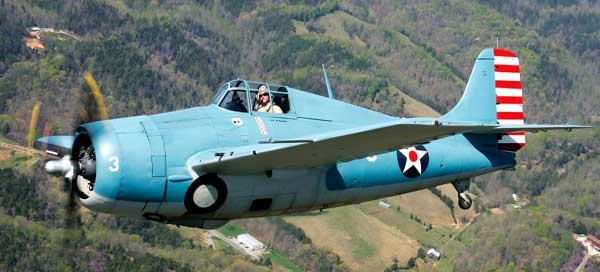
Supplementing the F4F-3s in service during 1942, the F4F-4s were soon in action in the Pacific, participating notably in the battles of the Coral Sea and Midway.
On April 18, 1942, Eastern Aircraft was made a second production source for the F4F with a contract for 1,800 examples of the F4F-4 designated FM-I, leaving Grumman free to concentrate upon the F6F Hellcat. Eastern, a group of five factories previously assembling General Motors cars, flew its first FM-1 on August 31, 1942, and delivered some 840 in the first 12 months, plus about 300 to Britain as Martlet Vs in 1942-3. The advent of the small CVE or escort carrier led to development of the final Wildcat version, the FM-2.
This combined the more powerful Wright R-1820-56 Cyclone engine with a lighter airframe to obtain improved take-off performance from the shorter carrier decks. Grumman built two prototypes as XF4F-8s, the first of these being flown on November 8, 1942, at Beth page; a production contract, initially for 1,265 examples designated FM-2, was placed with Eastern early in 1943. The FM-2 had a taller fin to counteract the increased engine power, and later aircraft in the batch had a water-injection system.
Eventually, Eastern built 4,127 FM-2s for the USN and 340 for Britain as Wildcat VI (the original British name of Martlet was dropped in favor of Wildcat in March 1944). The FM-2s became standard equipment on the majority of the 114 escort carriers put into service by the end of the war.
A contemporary of the Japanese Zero, the F4F in fact had an inferior performance in several respects, yet proved capable of holding its own thanks to its superior armament, rugged construction and well-trained pilots. During 1942 the ratio of victories to losses for air combat for the F4F was 59 :1, and for the whole war the official figure for the F4FJFM was 69 :1. A large proportion of these victories was obtained against bombers and transports, but the figures show that the Wildcat was not unsuccessful, especially in the first half of the war in the Pacific, when the Grumman design was the sole carrier-based fighter operating with the USN.
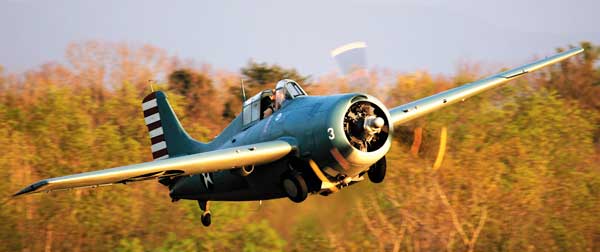
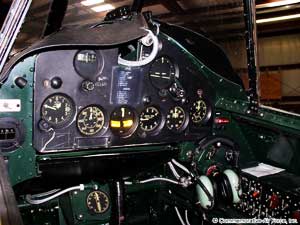 |
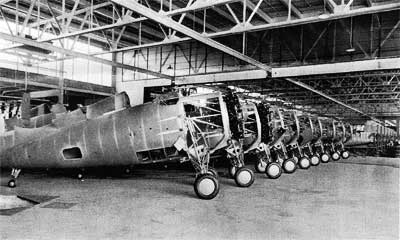 |
Grumman F4F Wildcat Cockpit. |
The Grumman F4F Wildcat Factory. |
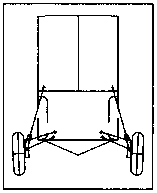 |
Grumman F4F Wildcat Landig Gear Animation. |
Specifications
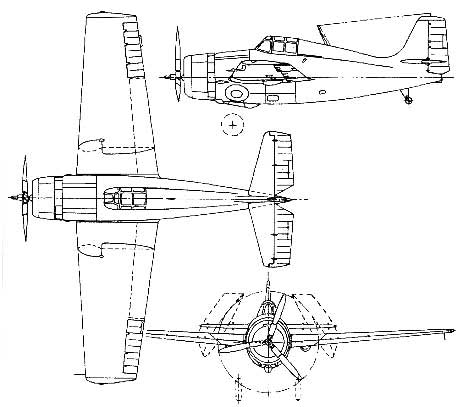 |
Length: 28 ft 9 in |
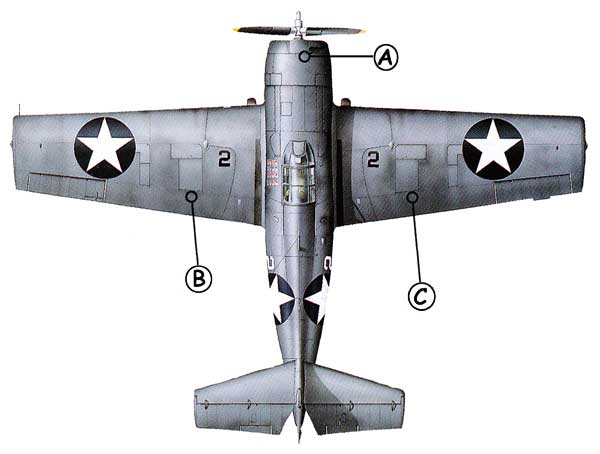 |
||
| A: The pilot was protected by thick armour behind the cockpit, bulletproof glass ahead. | B: The F4F Wildcat wing tanks contained 158 gallons of aviation gasoline, and were self sealing. | C: All-metal vacuum operated split trailing- edge flaps were fitted. |
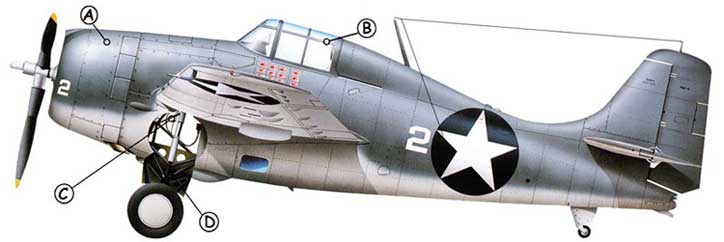 |
|||
| A: A rugged and powerful Wright Cyclone engine gave the F4F a good power-to-weight ratio. | B: The cockpit was rather cramped and visibility was not great. Immediately behind the pilot was a Mk 1A liferaft. | C: The F4F was heavily armed with no less than six wing machine guns. Not as powerful as a cannon, still adequate against most Japanese opposition. | D: The F4F undercarriage design with mainwheels only half retracting to lie flat against the lower fuselage in a shallow well. |
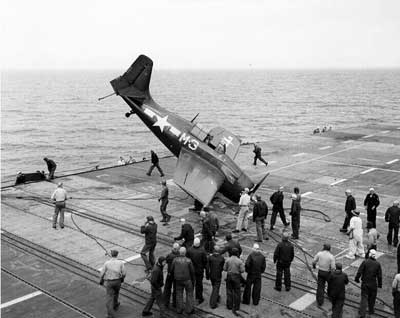 |
Grumman F4F Wildcat comes to a most spectacular standstill after a barrier crash on board USS Sable (IX-81), during pilot training in the Great Lakes, May 1945. |



